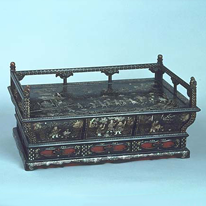Past Exhibitions
- From Land and from Sea: East Asian Lacquers with Mother-of-Pearl Inlay
- July 26, 2016 - August 28, 2016
Mother-of-pearl inlay is a decorative technique using the inner iridescent layer (nacre) of shell from a mollusk such as abalone or green turban. This layer is separated from the outer shell, cut into shapes, adhered to the surface of the object to be decorated, and inlaid. Methods of cutting, adhering, and inlaying differ around the world. Japanese artisans have developed techniques originally imported from China, using the sap of the lacquer tree as an adhesive and as a coating in which to inlay mother-of-pearl pieces. Korean and Ryūkyū (Okainawan) traditions began with the same imported techniques and then developed under mutual influence. In Japan, imported inlaid lacquers from East Asia were known as karamono (literally, “Chinese objects,” though they might come from Korea or Ryūkyū). They were prized, carefully preserved, and frequently copied by domestic artisans. Though their country of manufacture is sometimes difficult to discern, the many surviving works with nacre inlay represent various regions and historical periods. Enjoy this selection of East Asian works that utilize lacquer from the land and shell from the sea.












